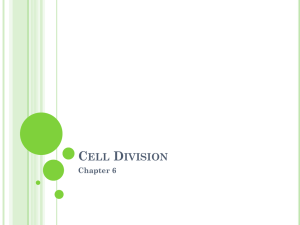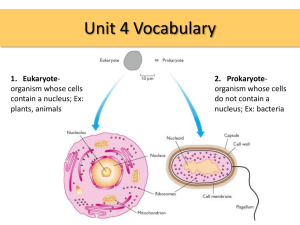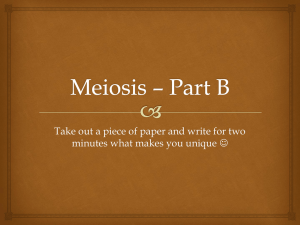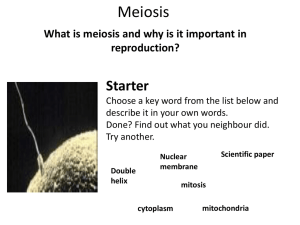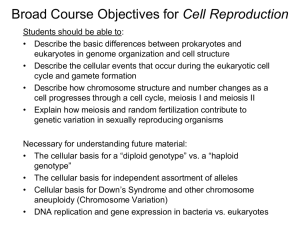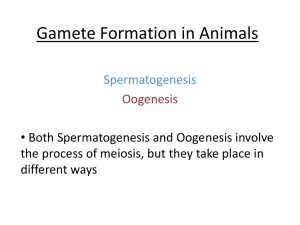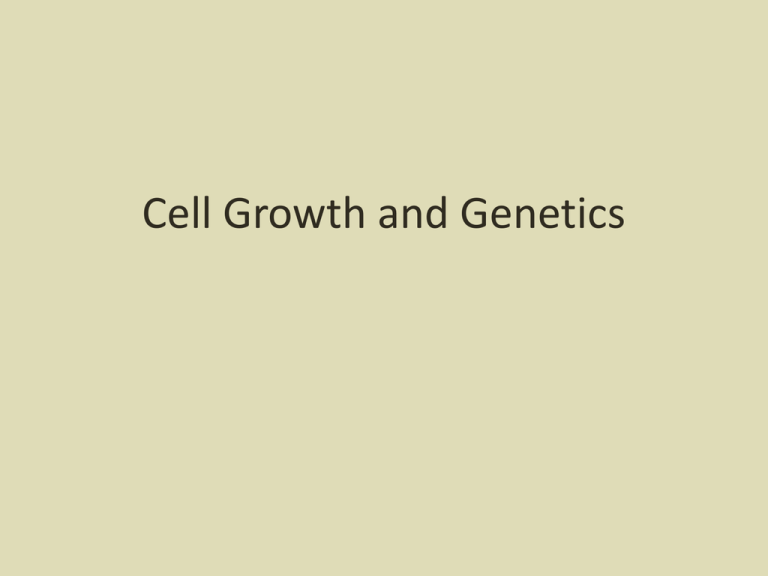
Cell Growth and Genetics
Cell Division (Mitosis)
Cell division results in two
identical daughter cells.
The process of cell divisions
occurs in three parts:
• Interphase - duplication of
chromosomes and
preparing the nucleus for
division
• Mitosis – organized division
of the nucleus into two
identical nuclei
• Cytokinesis- division of the
cell and cellular contents
into two identical daughter
cells
• Animation
1.) Mitosis and meiosis are processes by which animal and
plant cells divide. Which statement best describes a difference
between mitosis and meiosis?
A.
Meiosis is a multi-step process.
Both processes have multiple steps (prophase, metaphase,
anaphase, and telophase, but meiosis has two sets of these
stages with slight differences than the mitosis versions)
B. Mitosis occurs only in eukaryotic cells.
Mitosis occurs in prokaryotic and eukaryotic cells
C. Meiosis is used in the repair of an organism.
Mitosis is the process used to repair an organism by creating
more of the same type of cell (for example, to heal a cut on the
leg)
D. Mitosis produces genetically identical daughter cells.
Meiosis produces genetically different cells as a result of
crossing over and chromosome shuffling
Meiosis
• Meiosis occurs during the
formation of sex cells (sperm
and egg). It is necessary so
that the sex cells only have
half the number of
chromosomes (23 in us) so
that at fertilization, the normal
chromosome number is
returned (46 in us)
• Meiosis involves two divisions.
It begins with the replication
of the chromosomes, divides
up the cell into two cells, then
divides again (without
replication) into 4 genetically
different sex cells with half the
normal number of
chromosomes
2.) Use the illustration below to answer the question.
Cell Division
Which statement best describes the phase of the cell cycle shown?
This diagram is showing the formation of two cells
A. The cell is in prophase of mitosis because the number of chromosomes has doubled.
B. The cell is in prophase I of meiosis because the number if chromosomes has
doubled.
C. The cell is in telophase of mitosis because the cell is separating and contains two copies
of each chromosome.
D. The cell is in telophase of meiosis because the cell is separating and contains two copies
of each chromosome.
At the end of meiosis, you would see 4 genetically different cells with only one copy
of each chromosome (here you see 2 cells, and each has 2 matching “sticks” in it)
Nondisjunction and Patau’s syndrome
Nondisjunction
Karyotype of a normal male
Karyotype of a Patau’s male (notice
chromosome #13 has three
chromosomes instead of two
3.) Patau syndrome can be a lethal genetic disorder in mammals, resulting
from chromosomes failing to separate during meiosis.
• Part A: Identify the step during the process of meiosis
when chromosomes would most likely fail to separate.
• Most likely chromosomes would fair to separate during
anaphase I or Anaphase II. In anaphase, chromosomes
(anaphase I) or sister chromatids (anaphase II) are
supposed to separate, or move AWAY from each other. This
is called Nondisjunction.
• Part B: Describe how chromosome separation in meiosis is
different from chromosome separation in mitosis.
• During meiosis cells and the genetic material is divided
twice (the first set of division is meiosis I and the second set
is meiosis II). In mitosis, the cell and chromosomes divide
once.
Part C: Compare the effects of a disorder caused by chromosomes failing to
separate during meiosis, such as Patau syndrome, to the effects of
chromosomes failing to separate during mitosis.
• Due to the improper number of
chromosomes, the organism has an
improper amount of genetic material in
the form of DNA of the sperm or egg.
This mutation will be found in every cell
of the organism’s body.
• If chromosomes fail to separate during
mitosis, it does not affect the sex cells
but a body cell. This mutant body cell
then can be reproduced and produce
more of the abnormal cells. The cell
either dies or is replicated quickly. This
could possibly lead to cancer if the cells
are not destroyed by the immune
system.
DNA Replication
• This is key for DNA
replication. DNA (a double
stranded molecule) splits
into two halves, and each
half serves as a “template”
or pattern to build the new
half.
• The result is two identical
strands of DNA
– Adenine always pairs with
Thymine (straight line
letters AT go together) and
Guanine always pairs with
Cytosine (curvy letters GC
go together)
4.) Which process helps to preserve the genetic information
stored in DNA during DNA replication?
A.) The replacement of nitrogen base thymine
with uracil.
B.) Enzymes quickly linking nitrogen bases with
hydrogen bonds.
C.) The synthesis of unique sugar and phosphate
molecules for each nucleotide.
D.) Nucleotides lining up along the template
strand according to base pairing rules.
An embryonic cell divides repeatedly, with each
new cell containing all the genetic information
to form the entire organism. Which feature of
DNA ensures that genetic information is
conserved as it is replicated?
a. the role of DNA in protein synthesis
b. the polymeric nature of the DNA molecule
c. the complementary nature of DNA nucleotides
d. the triplet code with which information is stored on
DNA
25.) In a flowering plant species, red flower color is dominant
over white flower color. What is the genotype of any
red-flowering plant resulting from this species?
A. Red and white alleles present on one
chromosome.
B. Red and white alleles present on two
chromosomes.
C. A red allele present on both homologous
chromosomes
D. A red allele present on at least one of two
homologous chromosomes.
Genetics
• Dominant traits are represented by capital letters,
while recessive (non-dominant traits) are represented
by lower case letters.
– Each parent has two copies of the gene, so they will get
two letters. The different letters represent the different
alleles (flower pedal color) of a trait.
– Since white is the recessive trait, in order to have white
petals, the flower has to be ff or pure for the white trait.
– Since red color is dominant, the red parent could be Ff or
FF since it shows red petals. It is either pure for the red
trait or a hybrid for red.
• When the dominant trait shows, only one allele (form
of the gene) must be present to show the trait.
Punnet Square Animation
5. Green Pods are dominant over yellow pods in
pea plants. What is the probability of producing
a plant with green pods if two plants both
heterozygous for pod color, are crossed?
a. ¼
b. ½
c. 3/4
d. 1



